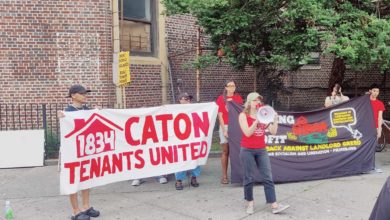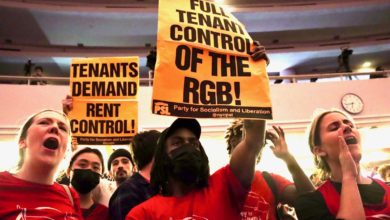As living conditions continue to decline throughout the country and poverty increases, the need for low-cost housing is on the rise. Yet working-class families are finding it increasingly difficult to find a place to live.
From Miami, to New York, to Los Angeles, capitalist developers are prioritizing the development of luxury
|
A study by the Southern California Association of Non-Profit Housing released Sept. 7 found that 12,800 affordable rental units were built throughout Los Angeles since 2001. That figure would be encouraging. But, as new low-cost housing was built, nearly the same amount was destroyed. During the same period, more than 11,000 older rent-controlled apartments were demolished or converted into high-cost condominiums. (Los Angeles Times, Sept. 7)
The study also found that the loss rate has accelerated, far outpacing new construction since 2005.
On the west side of Los Angeles, over 4,000 units of rent-controlled housing—one-third of all the rent-controlled housing in Los Angeles—were demolished or converted. This means that people, who had lived in rent-controlled areas for years, even decades, were forced to move to a different area of the city or out of the city entirely.
Market-rate rents in Los Angeles rose over 30 percent from 2001 to 2005. They now average $1,770 per month. This is increasingly unaffordable to the great majority of the city’s population. (Los Angeles Times, Sept. 7)
What’s behind the displacement of people in low-cost housing? The answer is simple: gentrification.
Gentrification is a racist economic process that changes working-class neighborhoods into wealthier communities. It displaces people, creating changes in the social, economic, cultural and physical aspects of a neighborhood.
One result of gentrification is what’s happening in Los Angeles: housing prices begin to rise, and landlords evict long-time tenants in order to acquire greater profits by rebuilding or renting or selling to more affluent people.
Working-class neighborhoods in major U.S. cities, especially neighborhoods populated by people of color, are targets of the greatest gentrification efforts.
The gentrification that is taking place in Los Angeles and all over the country is a result of the overall drive in capitalist society to make profits for the small percent of those who benefit from the system.
Gentrification for profits
Capitalist landlords, bankers, and owners are the ones who control the economic, social and political apparatus of U.S. society. These people direct the gentrification process, often with help from their allies in city and state governments.
As is happening in Los Angeles, landlords and developers spend immense amounts of money to construct and renovate housing units or apartments. They get loans from the banks to do so. Once built, the housing is not replaced for years, because it would necessitate another major financial investment.
So, the buildings’ values continuously decline. If the buildings are rentals, landlords can deduct from their taxes the amount that the building has depreciated.
Some landlords keep their properties in decent shape. This happens, for the most part, in wealthy urban areas. If landlords keep up their buildings, the surrounding area won’t be threatened with gentrification. These areas likely will remain prosperous.
In other areas, when buildings get older and their value depreciates, landlords resist spending money on repairs.
|
The capitalist-run housing market classifies people according to their income level and race. If a community is populated by lower-income residents, landlords tend to neglect those properties.
The costs of repairs or renovations would require higher rents, which the tenants cannot afford and are costs the capitalist landlords are unwilling to absorb.
The capitalists allow buildings in a neighborhood to become dilapidated if they have decided that it isn’t beneficial to continue to invest in that neighborhood. What the landlords save on renovations and repairs they can use to purchase other properties in areas where they can extract more profits.
Housing for all
Under the capitalist system, there are even laws protecting the “rights” of landlords—the Ellis Act is a California state law allowing landlords to remove themselves from the rental market and offer residential units for sale instead.
Landlords and developers don’t care about people’s basic housing needs. Their goal is to put the minimum amount of money into what they own and to extract the maximum amount of profit.
The Southern California Association of Non-Profit Housing supports a moratorium on the demolition or conversion of rent-controlled apartments. Such a moratorium is a worthy short-term goal, but more is needed.
At minimum, millions of low-cost housing units must be built in Los Angeles and across the country. This housing must be well constructed, affordable and available to all workers and unemployed people. Everyone deserves housing. Having shelter is a basic human need.
Revolutionaries and progressives should fight to stop gentrification and for access to affordable housing, but these goals should not be the end of our efforts.
High-cost housing is a fixture of capitalism. As long as housing is built to generate profits, capitalist owners and bankers will rush to maximize their financial gain at the expense of the working class. To solve the massive housing problem in this country, a socialist system based on meeting human needs must be established.








